Understanding how to measure a bike frame is crucial, whether you’re considering purchasing a new bicycle, renting one for a ride, or simply want to ensure your current bike fits you perfectly. Bike frame measurements are the foundation of bike fit, directly impacting your comfort, efficiency, and overall riding experience. Different manufacturers may employ varying sizing conventions, making it essential to grasp the fundamental measurements to accurately compare different bikes and find the right size for your needs.
This guide will walk you through the essential measurements that define a bike frame, whether you’re interested in road bikes or mountain bikes. Knowing these measurements empowers you to make informed decisions, ensuring you select a bike that’s not only the correct size but also suitable for your intended riding style. Let’s dive into how to accurately measure your bike frame and understand what each measurement means.
Essential Bike Geometry Measurements Explained
Before we get into the practical steps of measuring, let’s clarify the key bike geometry measurements. These dimensions are crucial for understanding a bike’s characteristics and how it will perform. Here’s a breakdown of the terms you’ll encounter:
- Top Tube Length (Effective): This is the horizontal distance from the center of the head tube to the center of the seat post. It’s often referred to as the ‘virtual’ or ‘effective’ top tube length, especially on bikes with sloping top tubes, providing a consistent measurement for comparison.
- Seat Tube Length: Measured from the center of the bottom bracket to the top of the seat tube. Note that seat tube designs can vary, with some extending significantly above the top tube junction or using seat masts, which can make direct comparisons challenging.
- Reach: The horizontal distance from the center of the bottom bracket to the center-top of the head tube. Reach is a critical measurement for determining the bike’s cockpit length and rider position, independent of seat tube angle.
- Stack: The vertical distance from the center of the bottom bracket to the center-top of the head tube. Stack height influences the bike’s front end height and rider’s vertical position, contributing to comfort and handling.
- Wheelbase: The distance between the front and rear wheel axles. Wheelbase affects the bike’s stability and handling; longer wheelbases generally offer more stability, while shorter ones can be more agile.
- Chainstay Length: The distance from the center of the bottom bracket to the rear axle. Chainstay length impacts power transfer and handling. Shorter chainstays often result in quicker acceleration and a more responsive feel.
- Front Center: The distance from the center of the bottom bracket to the front axle. Along with chainstay length, front center contributes to the wheelbase and influences weight distribution and handling.
- Seat Tube Angle: The angle of the seat tube relative to the horizontal plane. Seat tube angle affects rider position and weight distribution, impacting pedaling efficiency and comfort.
- Head Tube Angle: The angle of the head tube relative to the horizontal plane. Head tube angle is a significant factor in steering responsiveness and stability. Slacker angles are often found on mountain bikes for downhill stability, while steeper angles are common on road bikes for quicker handling.
- Bottom Bracket Drop: The vertical distance that the bottom bracket is positioned below the wheel axles. Bottom bracket drop influences the bike’s center of gravity and stability, particularly in cornering.
- Bottom Bracket Height: The vertical distance from the ground to the center of the bottom bracket. Bottom bracket height affects ground clearance and stability.
Understanding these terms will make the measurement process and the interpretation of bike geometry charts much clearer.
Tools You’ll Need to Measure Your Bike Frame
To accurately measure a bike frame, gather the following tools. These are readily available and will ensure precision in your measurements.
- Tape Measure: A standard retractable tape measure, preferably metric for consistency, is essential for measuring lengths.
- Clinometer (or Smartphone App): A clinometer is used to measure angles. Many free smartphone apps are available that can turn your phone into a clinometer. This is crucial for accurately measuring seat tube and head tube angles.
- Spirit Level (or Straight Edge with Clinometer App): A long spirit level ensures you’re taking horizontal or vertical measurements accurately. Alternatively, you can use a straight piece of wood or metal combined with your clinometer app.
- Plumb Line (or String and Weight): A plumb line, or a simple string with a weight like a small piece of Blu Tack or a washer at the end, is needed to establish a vertical reference for reach and stack measurements.
While metric measurements are the standard in the cycling industry, particularly for frame geometry, some manufacturers, especially in mountain biking, might still use inches for frame sizing. To maintain consistency and avoid confusion, we recommend sticking to metric units (centimeters and millimeters). If you encounter measurements in inches, remember that 1 inch is equal to 2.54 centimeters.
For modern bikes, manufacturers typically provide detailed geometry charts on their websites for each model and size. If your bike is a current model, consulting the manufacturer’s geometry chart is highly recommended. These charts are usually more precise than manual measurements and serve as an excellent reference point.
Step-by-Step Guide: Measuring Top Tube Length
 Top tube measurement demonstrated on a bike frame
Top tube measurement demonstrated on a bike frame
Alt Text: Measuring the effective top tube length of a bicycle frame using a tape measure, showing the horizontal distance between the head tube and seat post centerlines.
In the past, bike frames predominantly featured horizontal top tubes. Nowadays, many bikes are designed with sloping top tubes for various reasons, including improved standover clearance and frame stiffness. While geometry charts often list the ‘real’ top tube length, the most relevant measurement for sizing and comparison is the effective top tube length, also known as the virtual top tube length.
This measurement represents the horizontal distance between the centerline of the head tube and the centerline of the seat post. To measure it accurately:
- Position your bike on a level surface. Ensure the bike is stable and upright.
- Identify the center of your head tube and seat post. These are your starting and ending points for the measurement.
- Use your spirit level or clinometer app to ensure a horizontal measurement. Place the level against the top tube area, aligning it horizontally from the head tube to the seat post.
- Measure the horizontal distance. Using your tape measure, record the distance from the center of the head tube to the center of the seat post, keeping the tape measure perfectly horizontal as guided by your level.
Road bike sizing is often based on top tube length by many manufacturers. However, mountain bikes and some modern road bikes frequently use S, M, L, XL sizing conventions. It’s important to note that sizing can vary significantly between brands. For instance, a size Small frame from one brand might have a top tube length equivalent to a Medium from another. Even virtual top tube length measurements can be interpreted differently by brands. Colnago, for example, measures to a vertical projection from the top of the seat tube, which differs from other manufacturers and results in slightly smaller numbers. Always cross-reference geometry charts and consider reach and stack for a more comprehensive understanding of frame size.
Step-by-Step Guide: Measuring Seat Tube Length
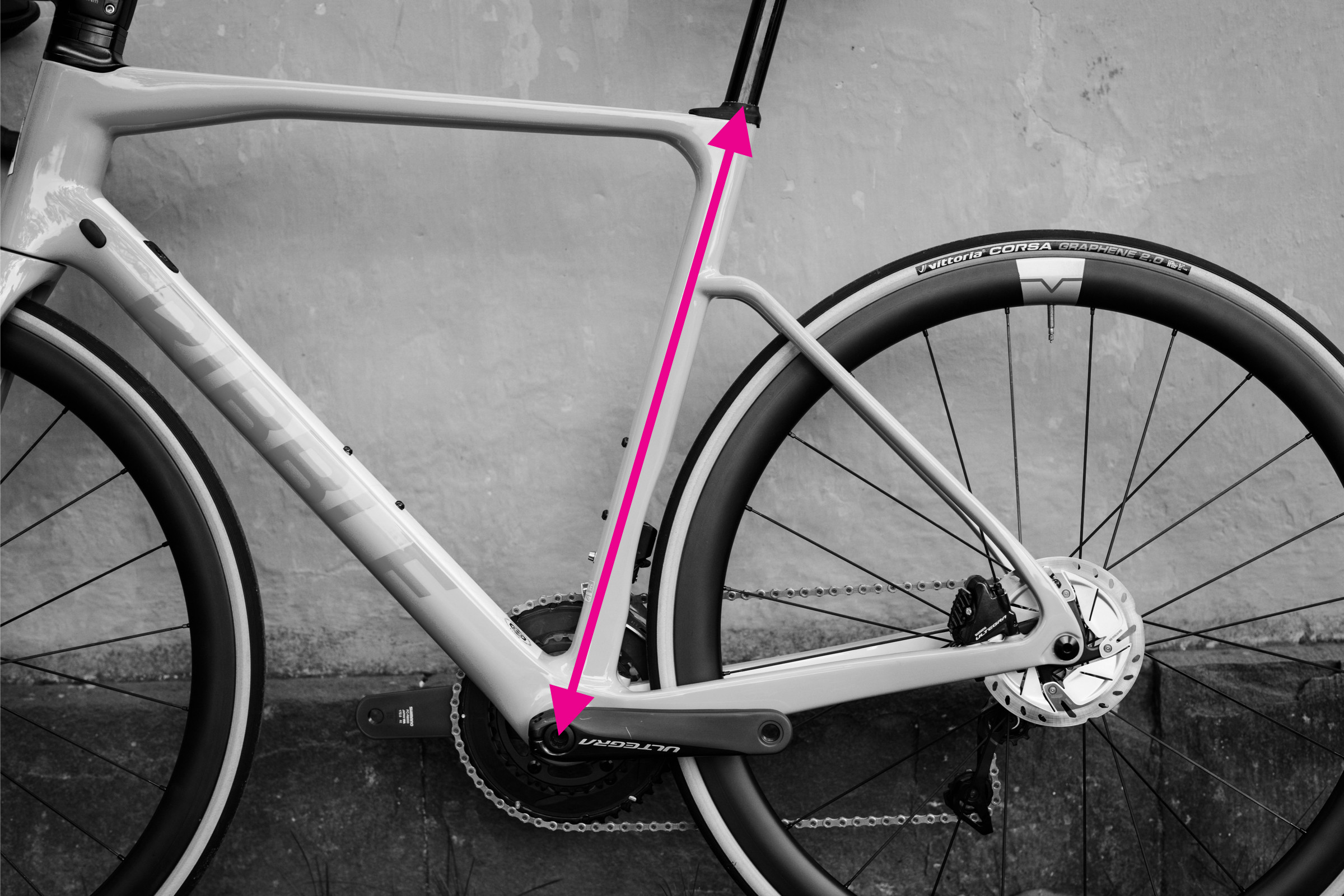 Seat tube measurement demonstrated on a bicycle frame
Seat tube measurement demonstrated on a bicycle frame
Alt Text: Illustration of seat tube length measurement on a bicycle frame, showing the vertical distance from the bottom bracket center to the top of the seat tube.
Seat tube length is measured as the straight-line distance from the center of the bottom bracket to the top of the seat tube. While seemingly straightforward, several factors can complicate this measurement:
- Identify the center of the bottom bracket. This is typically in line with the crank spindle.
- Locate the top of the seat tube. This might be the actual top of the tube or the top of an integrated seat mast, depending on the bike design.
- Account for variations in seat tube design. Bikes like the Trek Madone feature extended seat tubes, while others utilize seat masts. Mountain bikes often have kinks or bends in the seat tube.
- Measure the straight-line distance. Align your straight edge from the bottom bracket center to the top of the seat tube. Measure along this straight line to get the seat tube length. Avoid following the contour of the seat tube itself, especially if it’s bent, as this will yield an inaccurate, longer measurement.
Seat tube length is traditionally used for frame sizing, but with modern frame designs, it’s less indicative of overall bike fit compared to reach and stack.
Step-by-Step Guide: Measuring Reach and Stack
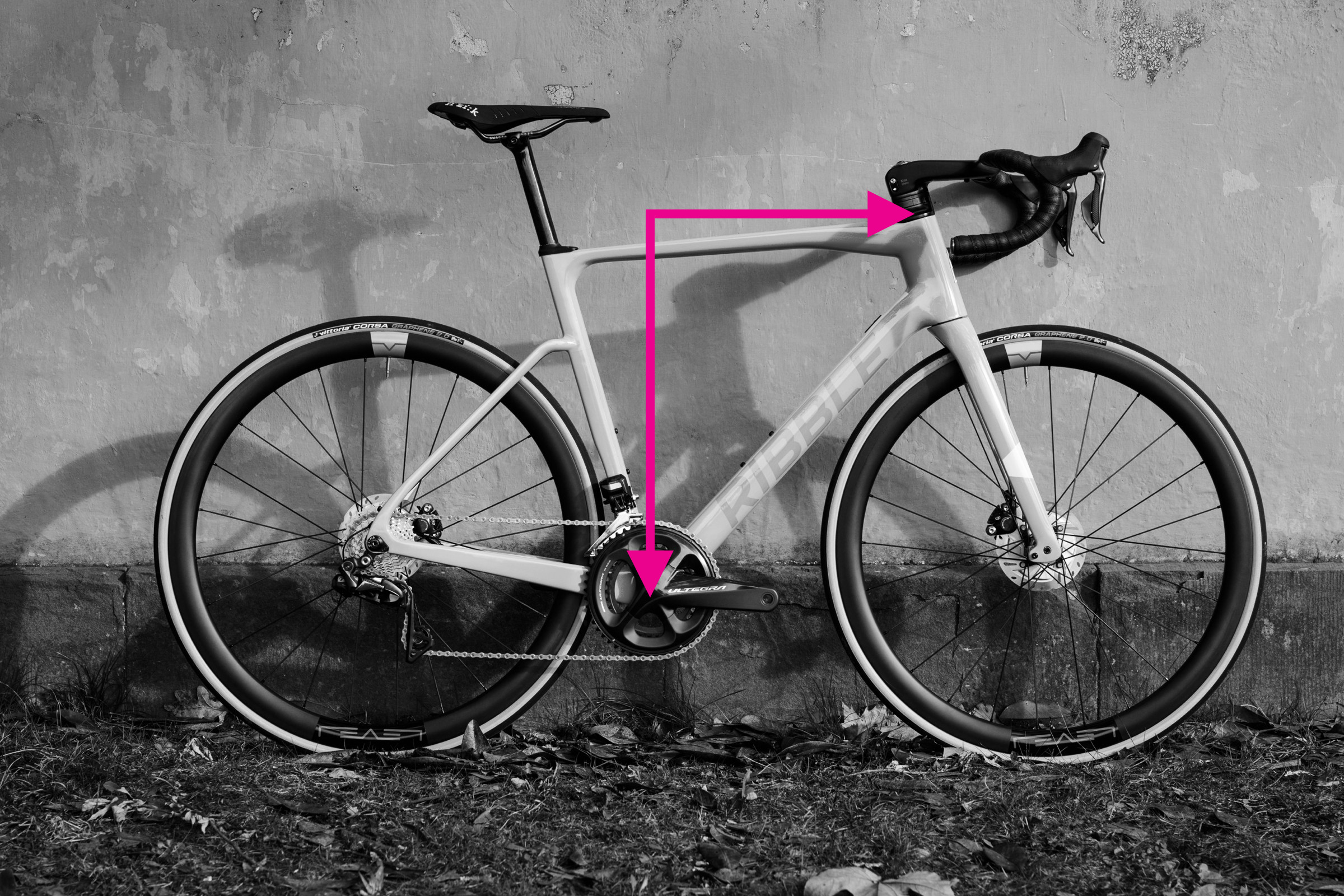 Stack and reach measurement demonstrated on a bike frame
Stack and reach measurement demonstrated on a bike frame
Alt Text: Diagram illustrating stack and reach measurements on a bicycle frame, showing the vertical and horizontal distances from the bottom bracket to the top of the head tube.
Reach and stack measurements have become increasingly important in modern bike sizing as they offer a more consistent and design-independent way to compare frame sizes. They measure the perpendicular distances between the bottom bracket and the top of the head tube, two critical contact points on the bike.
Measuring Reach:
- Set up your bike vertically and stable.
- Align your spirit level with the top of the head tube. Ensure it extends horizontally forward.
- Attach a plumb line to the spirit level. Let it hang freely. Ensure the weight at the end is stable and not swinging.
- Position the plumb line over the bottom bracket center. Adjust the level until the plumb line precisely intersects the center of the bottom bracket spindle.
- Measure the horizontal distance. Measure from the plumb line’s point of attachment on the spirit level to the center-top of the head tube. This horizontal distance is your reach.
Measuring Stack:
- Maintain the setup from reach measurement. The plumb line is still hanging from the spirit level, aligned with the bottom bracket.
- Measure the vertical distance. Measure the vertical distance from the spirit level (at the point where the plumb line is attached) down to the center-top of the head tube. This vertical distance is your stack.
Alternatively, for stack, you can measure the vertical distance from the ground to the top of the head tube and then subtract the height of the bottom bracket from the ground. Both reach and stack measurements require care for accuracy. Repeating the measurements a few times is advisable to ensure consistent results. A second person can be helpful, especially when using the plumb line method, to hold the level steady and read the measurements.
Step-by-Step Guide: Measuring Wheelbase
 Wheelbase measurement demonstrated on a bike frame
Wheelbase measurement demonstrated on a bike frame
Alt Text: Wheelbase measurement on a bicycle, depicting the distance between the front and rear axle centers.
Wheelbase, the distance between the front and rear axles, is a key factor in a bike’s ride quality and stability. It varies with frame size and design. Measuring wheelbase is relatively straightforward:
- Position your bike straight. Ensure the front fork is pointing directly forward. Misalignment will lead to inaccurate measurements.
- Measure from axle to axle. Use your tape measure to record the distance from the center of the front axle to the center of the rear axle.
- Repeat and average. For increased accuracy, measure the wheelbase on both sides of the bike and calculate the average. This compensates for any slight fork misalignment.
Step-by-Step Guide: Measuring Chainstay Length
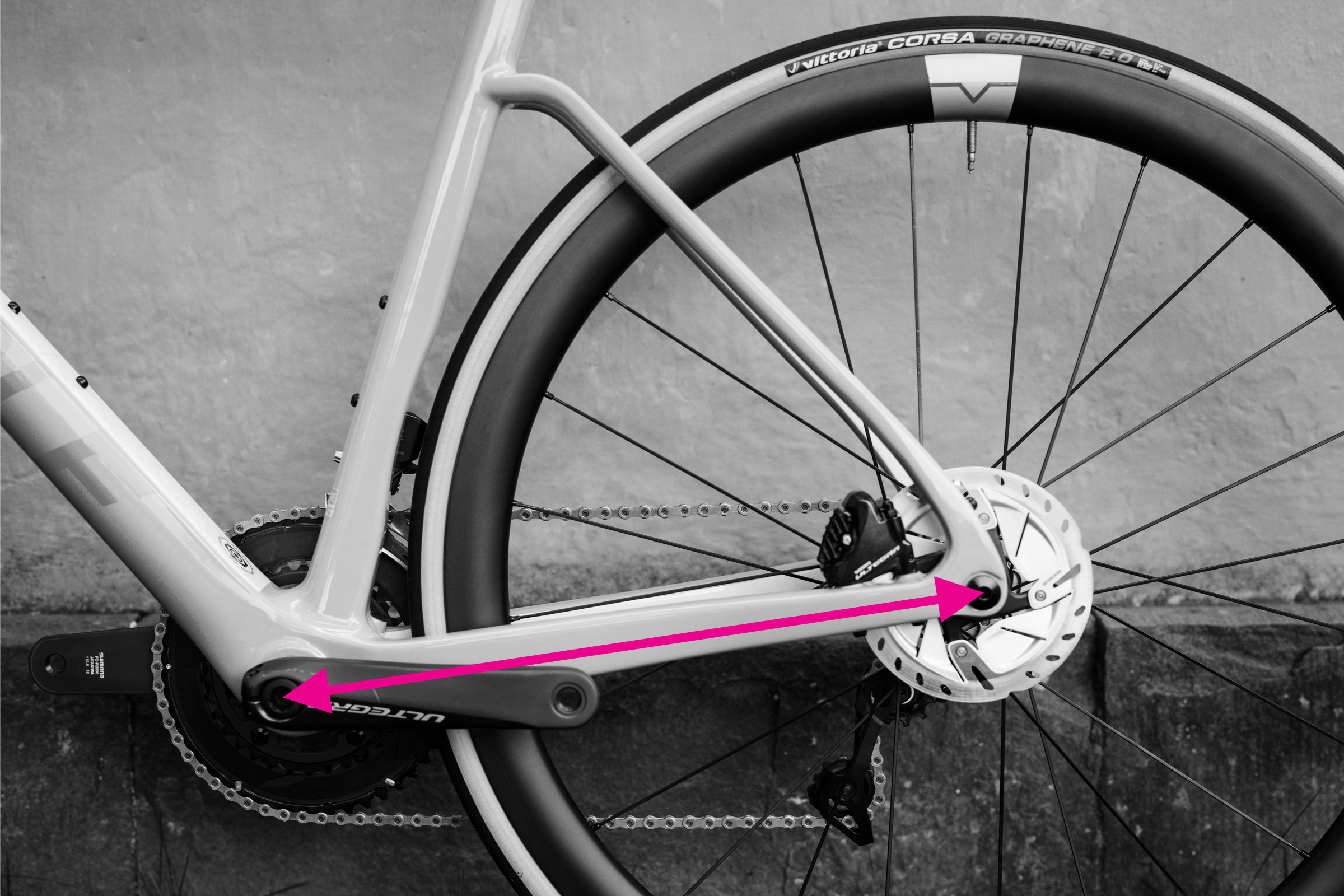 Chainstay length measurement demonstrated on a bike frame
Chainstay length measurement demonstrated on a bike frame
Alt Text: Chainstay length measurement on a bicycle frame, showing the distance from the bottom bracket center to the rear dropout.
Chainstay length is a crucial component of the wheelbase and significantly influences a bike’s handling. Shorter chainstays generally make a bike feel more agile and responsive.
- Locate the bottom bracket center and rear dropout. These are the measurement endpoints.
- Measure the straight-line distance. Use your tape measure to record the straight distance from the center of the bottom bracket axle to the center of the rear dropout.
Step-by-Step Guide: Measuring Front Center
 Front centre measurement demonstrated on a bike frame
Front centre measurement demonstrated on a bike frame
Alt Text: Front center measurement on a bicycle frame, illustrating the distance from the bottom bracket center to the front axle.
Front center is the counterpart to chainstay length, representing the distance from the bottom bracket to the front axle. It impacts handling and toe overlap.
- Identify the bottom bracket center and front axle. These are your measurement points.
- Measure the straight-line distance. Use your tape measure to find the straight distance from the center of the bottom bracket to the center of the front axle.
While not as commonly listed as other measurements, front center is provided by some manufacturers like BMC in their geometry charts. It’s important to note that wheelbase is not simply the sum of chainstay length and front center, as these measurements are not taken along the horizontal plane.
Step-by-Step Guide: Measuring Seat Tube and Head Tube Angles
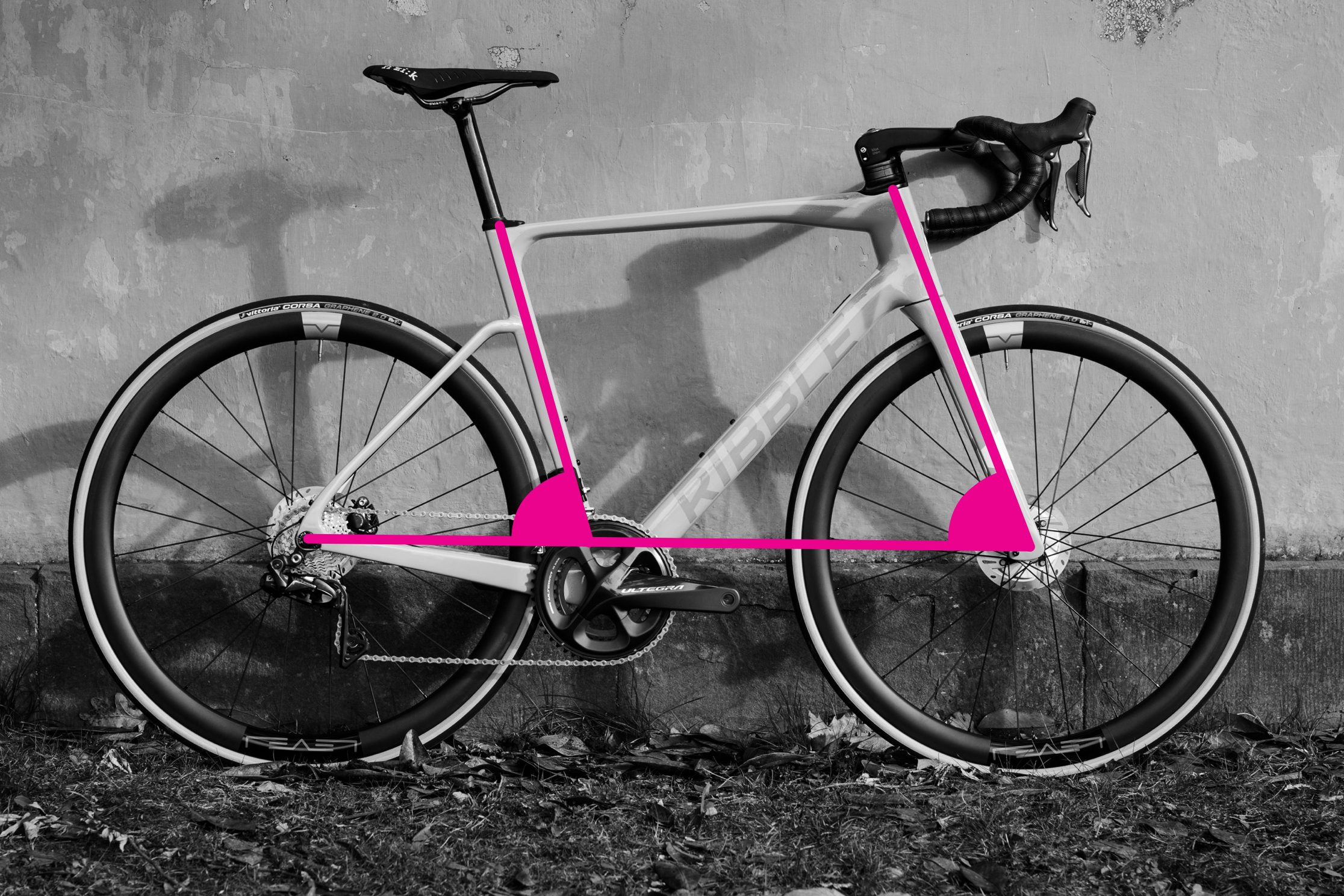 Seat and head tube measurements demonstrated on a bike frame
Seat and head tube measurements demonstrated on a bike frame
Alt Text: Measuring seat tube angle and head tube angle on a bicycle frame using a clinometer app on a smartphone.
Seat tube and head tube angles are critical determinants of a bike’s handling characteristics. Steeper angles generally result in quicker, more nimble handling. Your clinometer app is essential for these measurements.
Measuring Seat Tube Angle:
- Ensure your bike is vertical and on a level surface. Accurate angle measurements require the bike to be properly oriented.
- Align your smartphone with the seat tube. If the seat tube is straight, place your phone directly against it.
- Use a straight edge for kinked seat tubes. If there’s a bend, use a straight edge to span from the bottom bracket shell to the top of the seat tube, and align your phone against the straight edge.
- Read the angle from your clinometer app. This is your seat tube angle.
Measuring Head Tube Angle:
- Align your smartphone with the head tube. Modern bikes often have tapered head tubes. For the centerline angle, try to align your phone along the visual centerline or use a straight edge connecting the top and bottom centers of the head tube.
- Alternatively, measure the fork leg angle. If your fork legs are straight (without a bend at the crown), their angle will be the same as the head tube angle.
- Measure using the steerer extension. You can also get a reading by aligning the clinometer with the steerer tube extension above the head tube.
- Read the angle from your clinometer app. This is your head tube angle.
Step-by-Step Guide: Measuring Bottom Bracket Drop
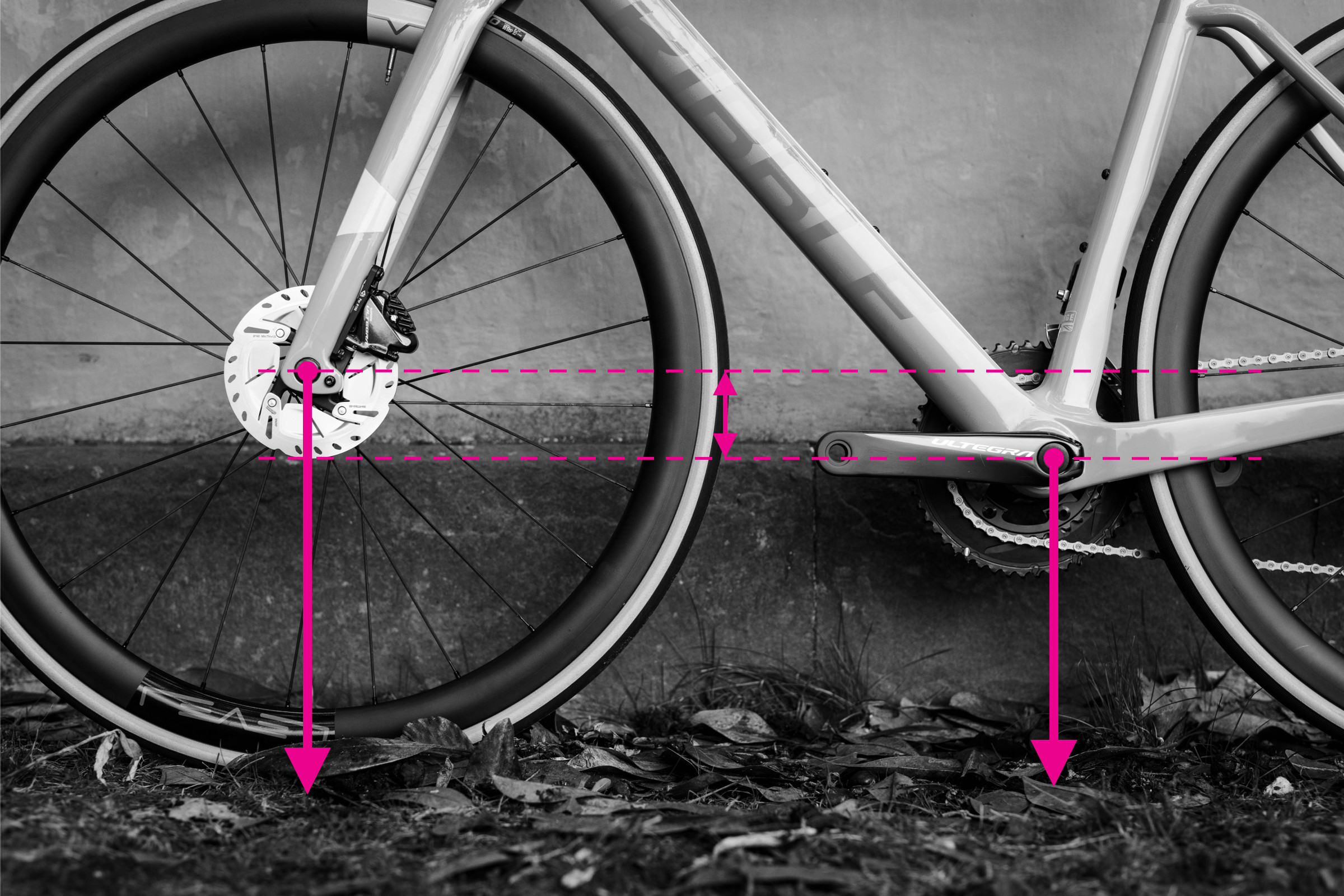 BB drop measurement demonstrated on a bike frame
BB drop measurement demonstrated on a bike frame
Alt Text: Bottom bracket drop measurement on a bicycle, showing the vertical distance between the wheel axle height and the bottom bracket center height.
Bottom bracket drop is the vertical distance the bottom bracket sits below the wheel axles. It influences stability and cornering.
- Measure the height of the rear axle from the ground.
- Measure the height of the bottom bracket center from the ground.
- Subtract the bottom bracket height from the rear axle height. The difference is your bottom bracket drop.
Step-by-Step Guide: Measuring Bottom Bracket Height
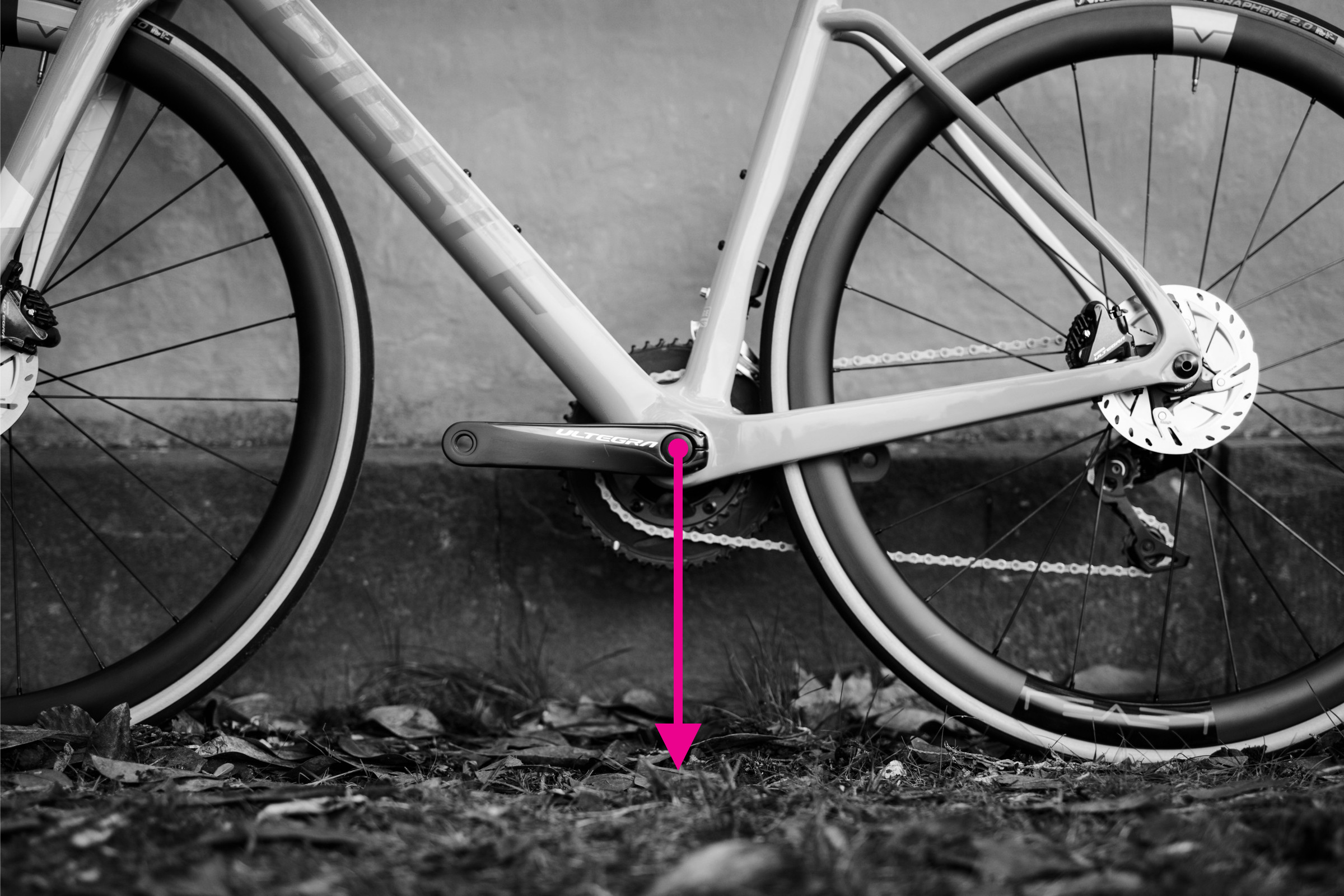 Bottom bracket height measurement demonstrated on bike frame
Bottom bracket height measurement demonstrated on bike frame
Alt Text: Bottom bracket height measurement on a bicycle, showing the vertical distance from the ground to the bottom bracket center.
Bottom bracket height is the distance from the ground to the center of the bottom bracket shell. It affects ground clearance and stability.
- Ensure your bike is upright on level ground.
- Measure the vertical distance from the ground to the center of the bottom bracket.
Remember that bottom bracket height can be slightly influenced by tire size and pressure. Inflate your tires to your standard riding pressure for the most accurate measurement.
Conclusion: Your Bike Frame Measurement Toolkit
By taking these measurements, you’ll have a comprehensive understanding of your bike frame’s geometry. This knowledge is invaluable when comparing bikes, assessing fit, and making informed decisions about purchasing a new or second-hand bike, whether it’s a road bike, commuting bike, or gravel bike. Keep your measurements in a safe place; they’ll be a useful reference for all your future cycling endeavors. Understanding how to measure a bike frame empowers you to take control of your bike fit and ensure comfortable, efficient, and enjoyable rides.
